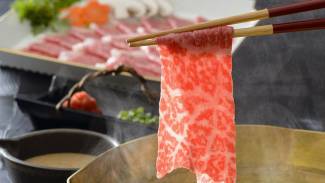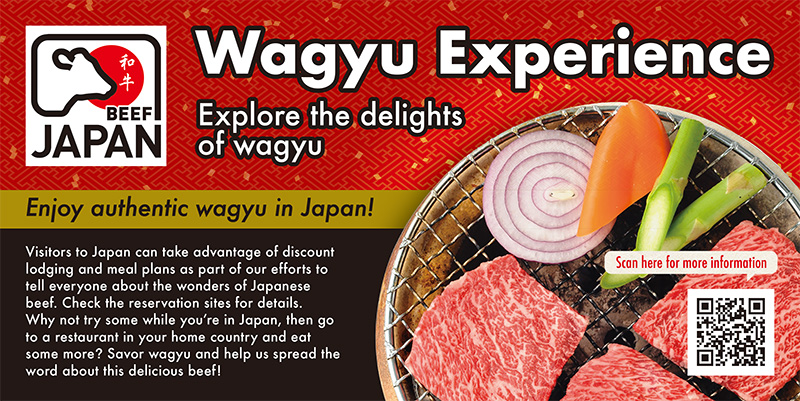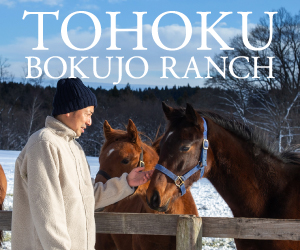WAGYU IN FUSION CUISINE
GLOBAL CHEFS OFFER THEIR VIEWS ON WAGYU
With standout features such as aromatic sweetness and buttery tenderness, wagyu continues to inspire new and experienced chefs across the world, earning their awe and respect as an ingredient that commands and deserves all the attention it gets.
The Japan Livestock Products Export Promotion Council (JLEC) has created an online wagyu compendium that includes hundreds of recipes from various countries. Adding more depth to this comprehensive resource are interviews with top chefs of Chinese, French, Italian and Japanese cuisine who express an intimacy with this star ingredient that has grown stronger over years of preparing it.
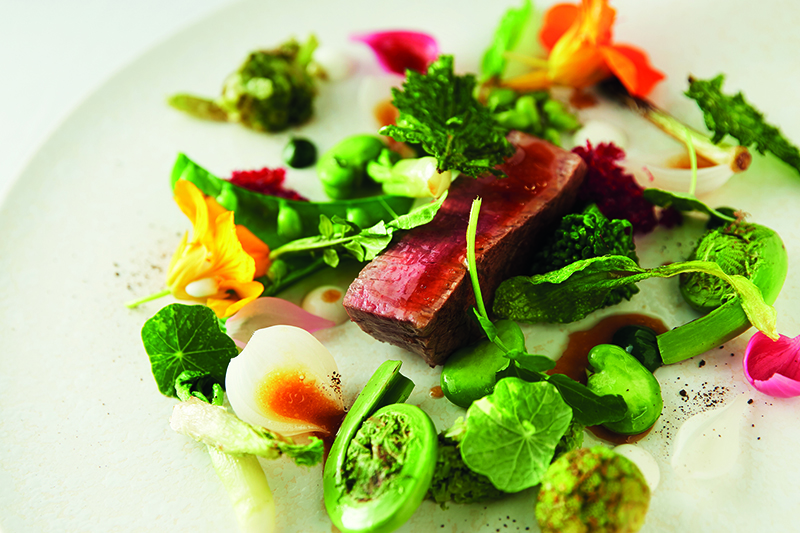
BVLGARI II RISTORANTE LUCA FANTIN
Wagyu around the world
Chef Adam Handling’s wagyu with black garlic and wild herbs is one of 20 listed recipes from London restaurants. Handling operates a restaurant in London’s Covent Garden. For this recipe, he uses wagyu knuckle for a balance of texture and fatty softness and serves it with a puree made with garlic that has been cooked at 60 C for eight weeks.
“I treated (the meat) the same way that I first got introduced to wagyu, sealing it and then slow cooking it on the barbecue. You get all them beautiful, smoky notes from the coal, but also slight caramelization. And we’ve served it with wagyu tongue,” Handling said in a video describing his dish.
For American chef Philip Lee, the focus is on “luxury” in his wagyu chuck roll and uni nigiri (sea urchin sushi). The dish is a thin slice of tenderized wagyu chuck roll on a bed of sea urchin on sushi rice, dressed with truffle and sea salt.
“Wagyu is one of those ingredients that is so easy to pair with so many things because it’s so robust, it’s got such a backbone that it is not easily overpowered,” Lee said, describing his choice of wagyu.
The approach of French chef of 35 years Patrick Bertron is that wagyu preparation calls for simplicity. In his dish — wagyu with iodized juice, puntarella (chicory sprouts), broth and slivers of smoked wagyu — onions are browned and pureed and puntarella bulbs are cooked in stock and stuffed with white vegetables. But the wagyu is “fried simply.”
“Japanese wagyu is really different and of an incomparable quality: The flavors stand out and the meat retains its juice. To prepare it, I recommend simplicity,” Bertron said.
A single wagyu cube from the rib or fillet is the centerpiece of Italian chef Marco Moreschi’s wagyu fried in grape oil, asparagus salad, lemon-flavored scampi, burrata (mozzarella and cream) and balsamic vinegar reduction. The meat is fried for 30 seconds before being placed on the salad and topped with the scampi and a fried basil leaf.
Although most of the wagyu information on the JLEC website is about cooking and eating the meat itself, there are also wine-pairing suggestions for wagyu dishes. Taku Iguro, a sommelier at L’osier who is featured in the Advice from Foreign Chefs section, explained that the compound lactone that gives wagyu its aromatic sweetness also develops in barrels of wine. This makes wagyu and wine a good match.
“Wagyu is often served in hot dishes, so one factor to consider is to ensure the wine is not chilled too much. If you raise the temperature, the wine will feel softer. You’d feel a soft and rounded texture, so when considering the drink, do consider the temperature,” Iguro said.
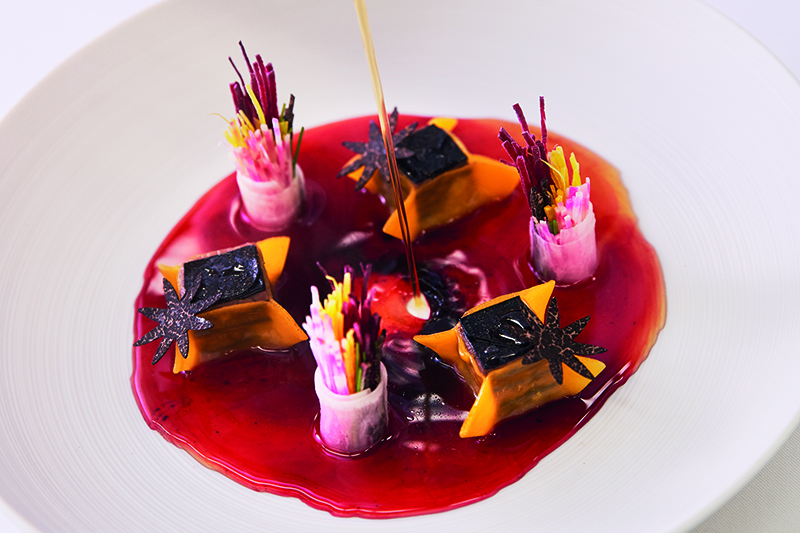
L’OSIER
Cooking tips from the experts
On the JLEC website, six top chefs praise wagyu’s versatility and provide guidance on how to pick, cook and enjoy different cuts.
Chef Michael Michaelidis of Joel Robuchon in Meguro cooks wagyu rib loin quickly on a teppan (iron grill) to give the meat a crispy texture. This cut is ideal for those who prefer some chewiness in their meat, and “addictive” wagyu always leaves one wanting more.
“In fine dining, it’s important not to mix too many ingredients, so wagyu is perfect for a chef. There is not much to add, it is already a very refined product,” Michaelidis said.
Hiroshi Sasaki, chef and owner of Gion Sasaki in Kyoto, said wagyu’s charm also lies in pulling out flavors from different cuts through different ways of cooking the meat.
“The quality of fat differs from cut to cut. We need good ideas to bring out the best in each cut, to use every part, leaving no leftovers,” Sasaki said. Gion Sasaki’s popular sukiyaki-style roast beef was born when Sasaki started searching for new ways to use round, a less sought-after cut.
Luca Fantin, executive chef at Ginza’s Bvlgari II Ristorante Luca Fantin, still remembers the first time he ate wagyu prepared in front of him on a teppan. His current method for serving it at his restaurant is to “cook it very fast, let it remain almost raw, that’s the best way.”
“For this dish, the meat must not be very tough, so I adapted cooking methods to bring out the best in the wagyu. With these methods, medium-rare is the best for wagyu. The meat should be 46 to 48 degrees in the center.”
While Fantin uses a large cut of meat for his main dish, for L’Osier Director and executive chef Olivier Chaignon, one little bite of wagyu is enough for a complete taste sensation. He creates a dish of thinly sliced fillet layered with truffle, steamed, grilled and cut into bite-size pieces, wrapped in ravioli and poached in a consomme broth. The dish is served with a bouquet of vegetables and beetroot sauce.
Wagyu achieves its tenderness and “endless possibilities,” Chaignon explained, because the animals are raised stress-free.
Head chef Ryusei Chin of Chinese restaurant Toh-Kah-Lin at The Okura Tokyo, added that wagyu’s traceability is a source of confidence for chefs as they can guarantee the provenance of the ingredients served to the hotel’s guests.
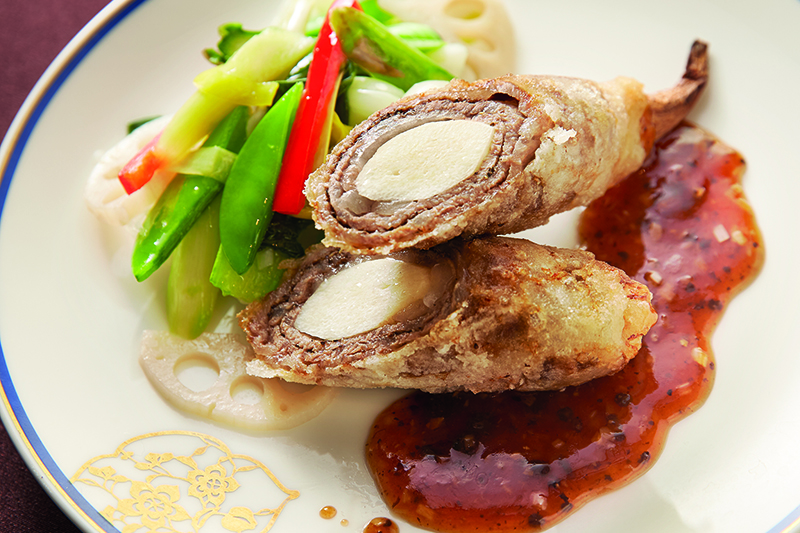
THE OKURA TOKYO
“Wagyu is often cooked rare to medium-rare, but it is so beautifully aromatic that as a Chinese cuisine chef, I like to use a wok burner and flash fry it on a high heat. With wagyu, even when it’s slightly overcooked, the smell is enticing.”
Jun Mishina, executive chef at Ren Mishina in Tokyo’s Ginza district, advises chefs to look carefully at the surface of the meat when choosing cuts, not the grade.
“Sirloin and rib loin are tender, so we often use them for sukiyaki or shabu-shabu (hot pot). Rump and top round butt are tender, too, but they also have a plump texture and are good with a charcoal flame or to sous vide. [Wagyu] is beautiful to fry, steam, grill, to sous vide. I can’t name many ingredients this versatile. That’s what makes wagyu from Japan stand out,” Mishina said.



